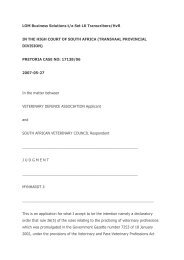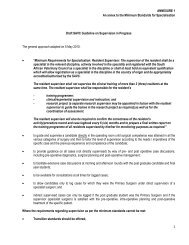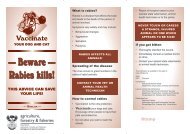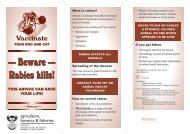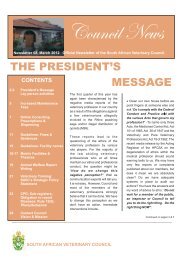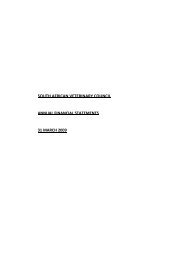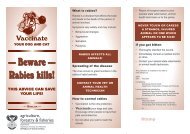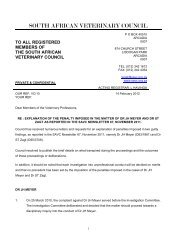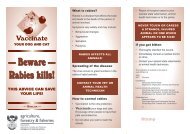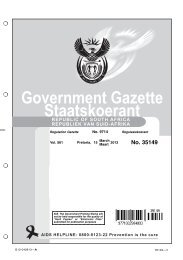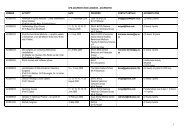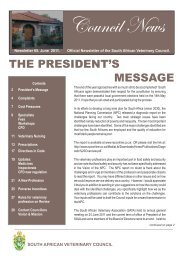Rabies Guide 2010.pdf - the South African Veterinary Council
Rabies Guide 2010.pdf - the South African Veterinary Council
Rabies Guide 2010.pdf - the South African Veterinary Council
Create successful ePaper yourself
Turn your PDF publications into a flip-book with our unique Google optimized e-Paper software.
Appendix 1<br />
Laboratory diagnosis of rabies in humans<br />
(Tests available at National Institute for Communicable Diseases at <strong>the</strong> time of press)<br />
Specimen<br />
Transport of<br />
Specimen*<br />
Laboratory<br />
Procedure<br />
Sensitivity/interpetation of<br />
Results<br />
Comments<br />
Saliva<br />
Plastic, screw top<br />
specimen jar/tube<br />
(need at least<br />
200 μl)<br />
RT-PCR<br />
Sensitive, but negative result does<br />
not exclude rabies virus infection<br />
Only patients with suspected<br />
rabies disease. Saliva<br />
specimens are preferred for<br />
ante mortem diagnosis. No<br />
sputum specimens.<br />
Virus isolation<br />
Sensitive, but is time-consuming<br />
Isolation of rabies virus may<br />
confirm o<strong>the</strong>r diagnostic tests<br />
Nuchal<br />
biopsy<br />
Two<br />
dermatological<br />
punches collected<br />
from <strong>the</strong> nape of<br />
neck:<br />
• 1 fresh on<br />
saline-wetted<br />
gauze in<br />
screw-top jar<br />
• 1 in formalin<br />
RT-PCR and<br />
histology<br />
Specimens are usually positive<br />
from day 1 of onset of clinical<br />
disease. Sensitive, but negative<br />
result does not exclude rabies virus<br />
infection<br />
Only patients with suspected<br />
rabies disease. Saliva<br />
specimens are preferred<br />
for ante mortem diagnosis.<br />
Specimen must include hair<br />
(virus is deposited in nerves<br />
around <strong>the</strong> hair follicles)<br />
Nuchal<br />
biopsy<br />
Plastic, screw top<br />
specimen jar/tube<br />
(need at least<br />
200 μl)<br />
RT-PCR<br />
Sensitive, but negative result does<br />
not exclude rabies virus infection<br />
Only patients with suspected<br />
rabies disease. Saliva<br />
specimens are preferred for<br />
ante mortem diagnosis<br />
Fluorescent<br />
antibody test<br />
Sensitivity depends when <strong>the</strong><br />
sample was collected (seroconversion<br />
time differs from<br />
patient to patient; sequential<br />
samples must be sent and may<br />
only be positive after 5 days of<br />
disease). A negative result does not<br />
exclude rabies virus infection<br />
Only patients with suspected<br />
rabies disease. Diagnostic<br />
since serum antibody induced<br />
upon vaccination does not<br />
cross <strong>the</strong> blood-brain barrier<br />
Serum<br />
Clotted blood<br />
tubes (need at<br />
least 200 μl)<br />
Fluorescent<br />
antibody test<br />
As for CSF<br />
Diagnostic in unvaccinated<br />
patients. Also for<br />
determination antibody titer<br />
upon vaccination<br />
Brain Half in 50 %<br />
glycerol saline**<br />
and half in 10%<br />
neutral buffered<br />
formalin**. In<br />
screw top jars***<br />
Fluorescent<br />
antibody test<br />
Virus isolation<br />
Gold standard for rabies diagnosis<br />
with a sensitivity of more than<br />
99%<br />
99% agreement with FAT results<br />
Entire brain (in two halves)<br />
or cubes of different sections<br />
of brain.<br />
Confirmatory test for<br />
fluorescent antibody test<br />
* Transportation: wrap specimen jar/tube in absorbent material and place in a sturdy container. Place in secondary container (i.e. courier<br />
boxes/bags) and transport at 4 ºC (cooler with frozen ice packs) to reach <strong>the</strong> laboratory as soon as possible. Apply necessary warnings<br />
for bio-hazardous/infectious materials to <strong>the</strong> package.<br />
** 50 % glycerol saline is prepared by adding an equal volume of glycerol to an equal volume of saline (for example 50 ml glycerol and<br />
50 ml saline); 10% neutral buffered formalin is prepared by adding 1/10 th volume of formalin to buffer (for example 10 ml formalin<br />
and 90 ml buffer).<br />
*** If brain cannot be preserved in glycerol saline/formalin, <strong>the</strong> brain may be frozen fresh and shipped on dry ice (or as cold as possible)<br />
to reach <strong>the</strong> laboratory ASAP. Warning: sample may degrade and influence outcome of testing.<br />
75



